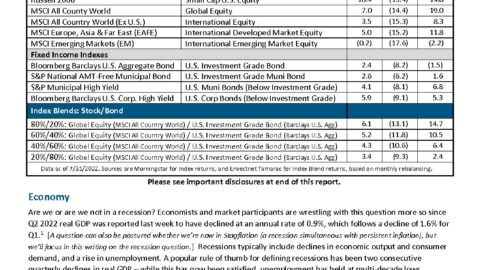I Can’t Itemize My Tax Deductions Anymore…Now What?!
By: Allie Schmidt, Financial Advisor,CFP®, CPA

Are you one of the many folks who itemized their income tax deductions in previous years, but not in 2018 with the new tax law? If so, you’re not alone. There is likely a significant decline in the number of people who itemized their deductions in 2018, as compared to previous years. The number one contributor to this change is the doubling of the standard deduction from $12,700 (married filing jointly) in 2017 to $24,000 in 2018*. A pretty substantial change. Couple that with the limiting of deductions from State and Local Taxes (“SALT”, which includes property tax) to $10k, and without substantial mortgage interest deduction, medical expenses, or charitable donations, there are less folks that exceed the standard deduction.
In my recent conversations with clients about their 2018 tax experience, this has come up as a frustrating point for people. Many have described it as “not getting a deduction for charitable giving or medical bills anymore” since they ended up taking the standard deduction. If you’re in this boat, there may a couple tax planning strategies that could help.
Bunching:
The first is lamely but appropriately termed “bunching”. This is where you strategically take deductions all in one year. You could do this with medical expenses by electing to have surgeries, do accessible upgrades to your home, purchasing medication, etc. all in one year. Or you could pay your property taxes for 2 years in one, assuming this will not exceed the $10k SALT limit once you take into account state income tax as well.
Likely the most applicable and fairly easily manipulated is charitable contributions. If you support a charity or charities each year, we’ve seen folks make those contributions for this year and next in the month of December, so that they can write off the full amount in the current year exceeding the standard deduction, then taking the standard deduction the following year.
Donor Advised Fund:
One step further, and you’ve heard me talk about this before, is a Donor Advised Fund. You’re able to set up a fund in your name and contribute whatever amount of cash or appreciated securities you’d like (up to 60% of AGI for cash and 30% of AGI for appreciated securities*) and take the full deduction in that year. Then, you’re able to make gifts to 501(c)3 organizations out of your fund over the next several years. For example, if you are used to giving $10k per year to charities, and don’t have enough other deductions to qualify to itemize your deductions, you could establish a Donor Advised Fund. Then you could fund the Donor Advised Fund with cash or appreciated securities of 5 years of contributions or $50k, receive the deduction in the current year, give to your selected charities over the next 5 years and take the standard deduction in the following years. This takes a little bit of planning, but can certainly be worth your time.
Qualified Charitable Distributions*:
The final strategy also revolves around charitable giving and could be a game changer for people over age 70.5 called Qualified Charitable Distributions (QCDs). A QCD is a direct transfer of funds from your IRA custodian (aka LPL Financial) payable directly to a qualified charity. In addition to supporting your charities, this method of donation (straight from IRA to charity, not through your bank account) excludes the amount donated from taxable income and can count towards your Required Minimum Distribution (RMD) for the year. This will help lower taxable income when it comes to social security, Medicare tax, and other credits and deductions. It also does not require you to itemize. So, you’re able to essentially get a deduction for your charitable contribution, since it is not reported as income, and may still take advantage of the higher standard deduction. This strategy has taken on a whole new meaning with 2018 tax law changes and the doubling of the standard deduction, however, a few rules apply. You must be 70.5 or older, the limit is $100k per year, excludes non-deductible contributions, and you must make the contribution by December 31st for it to count towards your RMD requirement. But if you stay within those limits, you’re in! This is an intricate option because it does not require a substantial upfront donation, but rather just a different way to get the funds to the charity.
The tax law changes in 2018 have certainly changed a couple ways to look at taxes to try to take advantage of the opportunities available, but there are options out there. Most of them just take a little more planning on the front end. Please reach out and let us know if you’d like to discuss any in more detail. When it comes to tax saving strategies, you can literally get paid for your time.
*irs.gov
Securities offered through LPL Financial, Member FINRA/SIPC. Investment Advice offered through HD Wealth Strategies, a registered investment advisor and separate entity from LPL Financial. The opinions voiced in this material are for general information only and are not intended to provide specific tax advice or recommendations for any individual. We suggest that you discuss your specific tax issues with a qualified tax advisor. This is a hypothetical example and is not representative of any specific situation. Your results will vary. Prior to investing in a 529 Plan investors should consider whether the investor’s or designated beneficiary’s home state offers any state tax or other state benefits such as financial aid, scholarship funds, and protection from creditors that are only available for investments in such state’s qualified tuition program. Withdrawals used for qualified expenses are federally tax free. Tax treatment at the state level may vary. Please consult with your tax advisor before investing.










